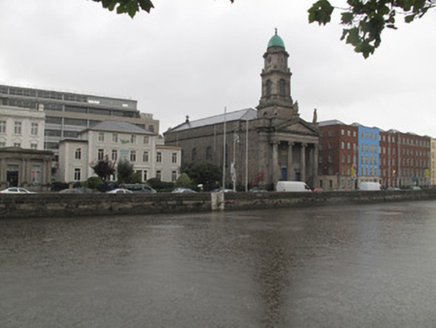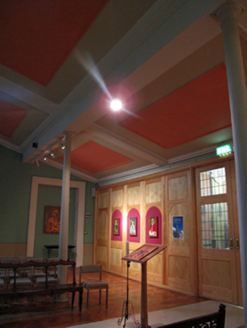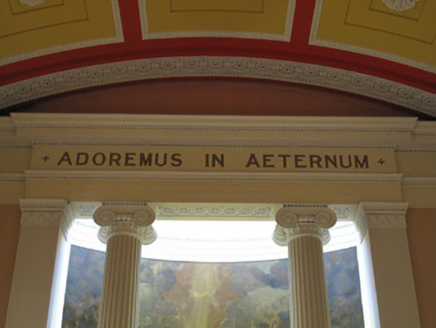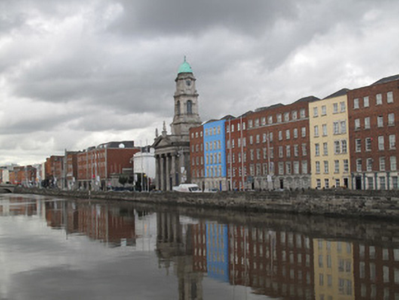Survey Data
Reg No
50070260
Rating
Regional
Categories of Special Interest
Architectural, Artistic, Historical, Social
Previous Name
Saint Gregrorios Syrian Orthodox Church
Original Use
Church/chapel
In Use As
Church/chapel
Date
1830 - 1850
Coordinates
314765, 234263
Date Recorded
18/10/2012
Date Updated
--/--/--
Description
Freestanding gable-fronted double-height Roman Catholic church, built between 1835-44, comprising five-bay nave fronted by single-bay narthex and pedimented tetrastyle Ionic portico, having square-profile three-stage bell tower over. Rendered former presbytery adjoining north elevation, single-storey hall and entrance porch to west dated 1897, recent single-storey lean-to extension flanking west elevation. Pitched slate roof, hipped to front (south). Clay ridge tiles, some cast-iron rainwater goods, masonry eaves course, masonry coping to rear, cruciform finial to apex. Copper dome to tower. Dressed calp limestone to side elevations, granite stringcourses, granite plinth course and dressed calp quoins to rear. Ashlar granite to front and east of narthex, portico and bell tower. Name plaque inlaid in wall within portico: 'ST. PAUL'S CHURCH @ SMITHFIELD'. Pedimented tetrastyle portico, having engaged pilasters and Ionic columns, both having anthemion ornament to necking. Figures of Saints Peter and Patrick flanking pediment, Saint Paul to apex. Cut stone walls to tower, having cut and carved corner buttresses and anthemion pattern frieze, broken pediment over clock face. Square-headed door openings to interior of portico, carved granite architrave surrounds and cornices, taller central opening, double-leaf timber panelled doors opening onto paved platform, nosed granite steps to footpath. Round-headed window openings to side elevations of nave having carved masonry surrounds and stained glass windows, cut stone sill course to east elevation. Square-headed door openings to east elevation with carved masonry surrounds, double-leaf timber panelled door, steps removed. Round-headed openings to tower, carved surround and impost course to second stage, timber louvered vents. Pitched slate roofs to hall, yellow brick laid in English garden wall bond, pilaster buttress with cut stone coping to porch, date plaque to gable with red brick voussoirs, pointed arch door opening with timber battened door. Interior with altar to north. Shallow barrel-vaulted coffered ceiling with foliate bosses and bands of guilloche. Plastered walls, with engaged pilasters supporting plaster cornices. Top-lit shallow apse having Ionic columns in antis, with mural depicting the Conversion of St. Paul and Corinthian colonnade to rear wall of apse, incorporating square-headed door opening, timber panelled door to sacristy. Decorative platband at sill level. Chamfered panelled reveals and sloped sills to stained glass windows to nave elevations. Square-headed blocked door openings to nave elevations, with carved surrounds, some having timber confessional boxes. Timber panelled gallery to rear supported on Ionic columns, pipe organ and seating to gallery, recent panelled partition wall under gallery. Marble baptismal font to rear of nave. Timber panelled half-glazed entrance porch. Timber floor. Marble steps to altar, iron railings removed, mosaic panels to floor of chancel. Carved marble altar table.
Appraisal
Saint Paul's forms a historic and visual focal point on Arran Quay. Designed by Patrick Byrne, it was built soon after Catholic Emancipation, when the Roman Catholic Church was beginning to build visible high-status buildings. Its tall Italianate bell and clock tower provides visual as well as contextual interest, with the inclusion of a clock, which was more common on Protestant Churches, implying a sense of public responsibility and thus increasing the status of the building. The elegant detailing on the portico, as well as the later figures to the pediment (Joseph Robinson Kirk, c.1870), provide decorative and technical interest to the façade, and are testament to the skill and craftsmanship of stone workers and sculptors in the nineteenth century. The very fine classical interior, with a wealth of quality materials and craftsmanship, adds to the overall architectural importance of this ecclesiastical site, despite the removal of some features such as the altar rails. Eamonn and Sinead De Valera were married here in 1910, adding a certain historical significance to the building. Artistic interest is added by the altar, by Farrell (before 1863), and a copy of Rubens Conversion of St. Paul by F.S. Barff (1863), which replaced an earlier representation of the crucifixion. The church had fallen into disuse, although currently it is used for some Catholic services as well as Syrian Orthodox services and Taize prayer.



























































